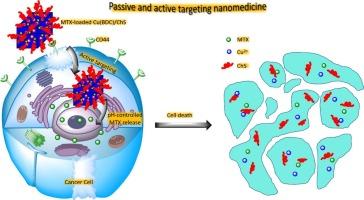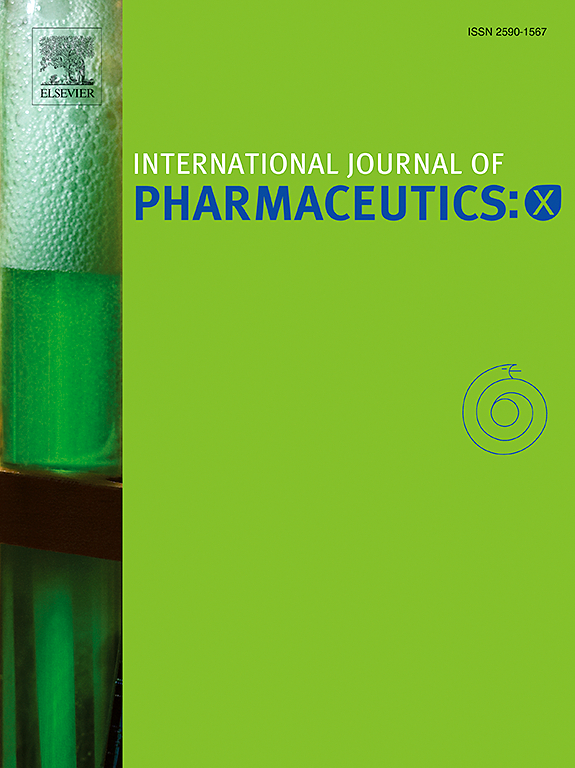Chondroitin sulfate-decorated cupper-benzene dicarboxylate framework as an efficient passive and active targeting nanomedicine for anticancer methotrexate delivery
IF 6.4
2区 医学
Q1 PHARMACOLOGY & PHARMACY
引用次数: 0
Abstract
In this research, an advanced drug delivery system was developed by decorating the copper-benzene dicarboxylate framework (Cu(BDC)) with the multifunctional chondroitin sulfate (ChS), termed Cu(BDC)/ChS. This novel system is designed for both active and passive targeting, featuring a pH-sensitive release mechanism that enhances drug effectiveness. Different characterization techniques confirmed the successful synthesis of the Cu(BDC)/ChS nanocomposite. In-vitro experiments evaluating the loading and release of methotrexate (MTX) showed that the release rate was significantly higher at pH 4.5, releasing 70 % over 92 h at 41 °C, in contrast to less than 20 % at pH 7.4 at 37 °C. This pH responsiveness of the Cu(BDC)/ChS promotes drug release in environments alike to tumor tissues. Additionally, cytotoxicity tests revealed that MTX-loaded Cu(BDC)/ChS exhibited considerable cytotoxic effects on MCF-7 cancer cells, with IC50 value of ∼250 μg/mL after 48 h, accompanied by an increase in apoptosis rates. Remarkably, the overexpression of CD44 receptors on cancer cell surfaces underscores the significance of ChS-functionalized systems in promoting selective cancer cell apoptosis, while exhibiting minimal cytotoxicity toward normal HUVEC cells. Overall, the findings indicate that the combination of Cu(BDC) and ChS holds promise for developing effective platforms for anticancer drug delivery.

硫酸软骨素修饰铜-二羧酸苯框架作为一种高效的抗甲氨蝶呤靶向纳米药物
本研究利用多功能硫酸软骨素(ChS) (Cu(BDC) /ChS)修饰铜-苯二羧酸盐框架(Cu(BDC)),构建了一种新型给药系统。这种新型系统设计用于主动和被动靶向,具有ph敏感释放机制,提高药物有效性。不同的表征技术证实了Cu(BDC)/ChS纳米复合材料的成功合成。体外实验评估了甲氨蝶呤(MTX)的负载和释放,结果表明,在pH为4.5时,释出率显著提高,在41°C下,92 h内释出率为70%,而在pH为7.4时,37°C下释出率低于20%。Cu(BDC)/ChS的这种pH响应性促进药物在类似于肿瘤组织的环境中释放。此外,细胞毒性试验显示,mtx负载Cu(BDC)/ChS对MCF-7癌细胞具有相当大的细胞毒性作用,48 h后IC50值为~ 250 μg/mL,并伴有凋亡率增加。值得注意的是,CD44受体在癌细胞表面的过度表达强调了chs功能化系统在促进选择性癌细胞凋亡中的重要性,同时对正常HUVEC细胞表现出最小的细胞毒性。总的来说,研究结果表明,Cu(BDC)和ChS的结合有望开发有效的抗癌药物传递平台。
本文章由计算机程序翻译,如有差异,请以英文原文为准。
求助全文
约1分钟内获得全文
求助全文
来源期刊

International Journal of Pharmaceutics: X
Pharmacology, Toxicology and Pharmaceutics-Pharmaceutical Science
CiteScore
6.60
自引率
0.00%
发文量
32
审稿时长
24 days
期刊介绍:
International Journal of Pharmaceutics: X offers authors with high-quality research who want to publish in a gold open access journal the opportunity to make their work immediately, permanently, and freely accessible.
International Journal of Pharmaceutics: X authors will pay an article publishing charge (APC), have a choice of license options, and retain copyright. Please check the APC here. The journal is indexed in SCOPUS, PUBMED, PMC and DOAJ.
The International Journal of Pharmaceutics is the second most cited journal in the "Pharmacy & Pharmacology" category out of 358 journals, being the true home for pharmaceutical scientists concerned with the physical, chemical and biological properties of devices and delivery systems for drugs, vaccines and biologicals, including their design, manufacture and evaluation. This includes evaluation of the properties of drugs, excipients such as surfactants and polymers and novel materials. The journal has special sections on pharmaceutical nanotechnology and personalized medicines, and publishes research papers, reviews, commentaries and letters to the editor as well as special issues.
 求助内容:
求助内容: 应助结果提醒方式:
应助结果提醒方式:


